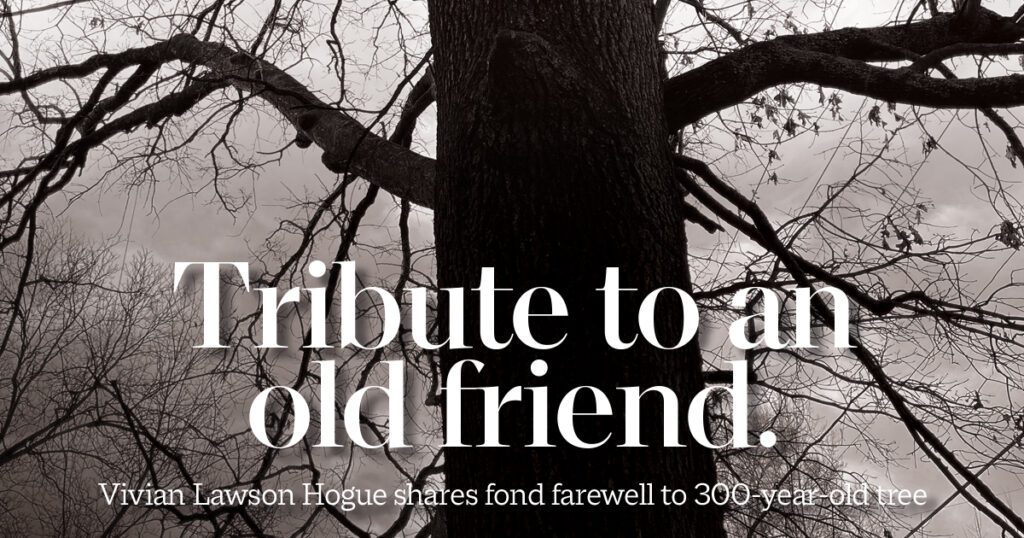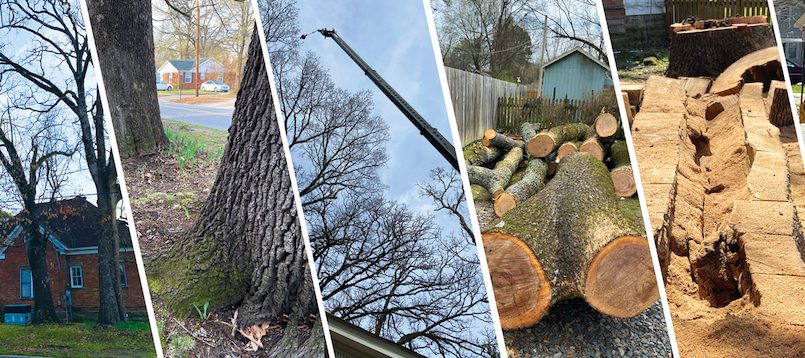02 Jun 2023 Tribute to an old friend
By Vivian Lawson Hogue
Our Old Conway trees are revered parts of my life. They have taken several hits lately due to strong winds, lightning, drought and simply old age.
Col. Asa Peter Robinson, a native of Connecticut, a Yale University engineering graduate and a railroad chief engineer, was awarded a section of land at a railroad stop called Conway Station. He chose this one-square-mile, 640-acre area for his retirement enjoyment.

Out of this prairie and forested area, he donated land to churches, schools and the county courthouse. As the town grew, he began to sell lots for homes. All warranty deeds had a stipulation: “No trees or shrubbery on said land or surrounding streets shall be cut, maimed, or destroyed except for embellishment or paths to buildings unless they are decayed or dangerous.”
The home in which I grew up was a part of the Robinson land. Built in 1910, its former landscaping included seven post oaks, one red oak, an American elm, a large redbud, a fringe tree, a chinaberry tree, a fig tree and a red maple. Today, most trees are clear-cut before neighborhoods are built. In earlier years, trees were valued for their beauty, shade and for shifting around hot summer air. Simpler building techniques of the time did not harm the trees.
Two very old oaks along our street within the view of my porch died from street and sidewalk construction in about 2009. A specially curved sidewalk was created around its now-former tree. Long ago, another nearby oak received the first curved sidewalk, and one near Central Baptist College was actually granted a “bubble out” curb to avoid its endangerment. Obviously, it risked being hit by one of the few vehicles per day traveling at a reckless 25 mph.
We Conway natives and long-timers are aware that the first things noticed by visitors are the tree boughs shading the streets. Yes, they sometimes fall and are sometimes damaged by lightning. Sometimes they take the least painful way out and simply uproot. They are, after all, much older than we will ever be and not always steady on their “feet.”
Their importance is immeasurable. They temper waves of heat rising from hard surfaces and are habitats for wildlife. The more we have, the more there are to clean the air we breathe by removing carbon dioxide and providing us with oxygen. They also release water into the air, prevent erosion and create economic value.

A tree was an issue on our own property recently. An expensive issue, but there was no arguing with the inevitable. There were two wonderful specimens standing very near each other, and I had known them personally all my life. One was a post oak, the other a red oak. They thickly shaded the west side of the house. My dad made a swing for me in the post oak, and at the base of the red oak, I became an “architect.” In 1953-54, our house was being remodeled to include a concrete porch. With vestiges of wet cement left in a wheelbarrow at the end of a workday, I built a miniature house and garage among the roots. My youngest brother, admittedly without his knowledge, provided small metal cars.
That the tree always leaned to the northeast never caused alarm. Starlings and squirrels, neither among my favorite critters, fought every year over a certain hole. However, four years ago I began to notice from my kitchen window that it seemed to lean more. I knew this friend that well. In fact, it was almost touching a cable from the house to the power lines. Utility workers once moved the cable a couple of inches, and then one day recently I saw it was touching the tree again. I knew what had to happen and it was heartbreaking. I couldn’t pretend all was OK.
If the 80-foot tree with a girth of 12 feet toppled, it would uproot its partner six feet away, rip out the cable to the street, and continue to knock down another oak and part of the front of our house. When all was said and done, after three days of men hard at work, I saw that some of the inside was black, the core was wood-colored but soft.
When I was a child, Arkansas experienced a three-year drought and we lost three oaks. After one was cut down, my dad counted the tree rings, one ring for every year of existence, and counted to 234. When I recently counted our own 68 years later, I reached about 260 and the rings disappeared, leaving only soft wood. Assuming there should have been more rings, we can safely say our trees are older than our country and sprouted around the year 1721. I pluck up self-seeded baby oaks often and remember that poet Ralph Waldo Emerson said, “The creation of a thousand forests is in one acorn.”
My thought on losing a tree is if you lose one you valued, plant another. Use caution, however. Never plant a tall-growing variety under a power line. But do learn to listen to tree inhabitants. The birds will chirp to tell you a storm is over. They have chirped a lot this spring.
- Salute to service - June 30, 2024
- One man plus One idea equals a 149-year-old city - June 2, 2024
- A look back at the forgotten women of the 501 - April 30, 2024











